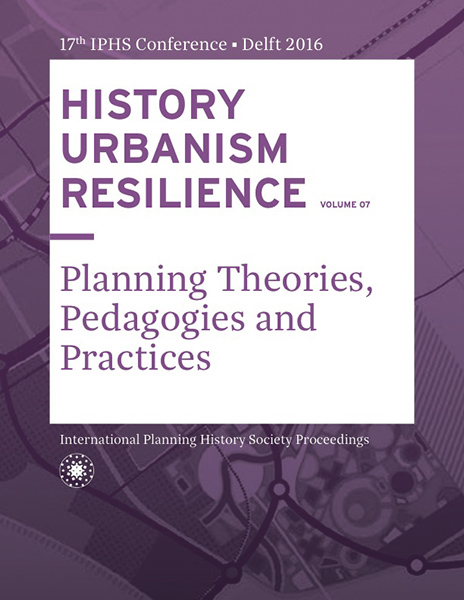Retracing the evolution of food planning to imagine a resilient food system
DOI:
https://doi.org/10.7480/iphs.2016.7.1341Abstract
Today the division between city and country is becoming more and more indefinite and it is not possible anymore to consider the rural landscape apart from the urban one.Observing Food System dynamics can be a very useful tool to survey territorial dysfunctions and spatial transformations in their complexity. Food, in fact, is one of the main flows crossing the landscape, according to the urban metabolism theory.
From the places of production, to the ones of consumption it involves built spaces and infrastructure; it is ruled by specific policies at different administrative levels, but also influenced by private initiatives and practices; it is a complex system of dynamics that changes the surrounding environment in each phase of the chain. Nevertheless Food system is also very sensitive to external pressure given by climate change and resources supply; in this sense a perspective of resilience could be a strategy to mitigate risks and make a territory or a city more able to adapt to surrounding transformations.
In the last fifteen years Food has risen inside the urban planners and designers debate as an autonomous topic, representing one of the main material flows in the urban metabolism theory, but since the beginning of the last century it was considered as an implicit theme inside the planning and urban design discourse, both by professionals and scholars.
In the evolution of the European urban design and planning, in fact, we can recognize several experiences in which food had a role in the formulation of new cities visions, during the XX century: the Garden City imagined by Howard and the “New Towns” movement at the beginning of the century; the Italian experience of autocracy between the 20's and the 30's; the Switzerland plan for a national food autonomy between the two wars; the vision for future cities in the Broadacre City project by Frank Lloyd Wright.
These experiences rose from very different premises and brought to very different results, both from the theoretical and the practical points of view, but all of them, in different ways, can teach us something in terms of integrating food and productive dynamics inside the urban system.
The paper will describe last century experiences from the Food System point of view, to understand how those stories anticipated some ideas related to urban metabolism and some approaches towards a more efficient and resilient territory.
References
American Psychological Association. The Road to Resilience.(2014). http://www.apa.org/helpcenter/road-resilience.aspx (retrieved on 2016, 15th March).
Ciucci, G., “La città nell’ideologia agraria e F. Ll. Wright. Origini e sviluppo di Broadacre”. In La città americana dalla guerra civile al New Deal, Ciucci, G., Dal CO, F., Manieri-Elia, M., Tafuri, M. (Roma: Laterza, 1973).
Cogato Lanza, E., Maurice Braillard e ses urbanistes. Puissance visionnaire et stratégies de gestion urbaine (Genève 1929-1936), (Genève: Editions Slatkine, 2003).
Folke, C., Carpenter, S., Walker, B., Scheffer, M., Elmqvist, T., Gunderson, L., Holling, C.S., “Regime Shifts, Resilience, and Biodiersity in Ecosystem Management”. Annual Review of Ecology, Evolution, and Systematics 35: 557-581 (2004).
Gillette, H.Jr., Civitas by Design. Building Better Communities from the Garden City to the New Urbanism (Philadelphia: University of Pennsylvania Press, 2010).
Giordani, P.L., “Considerazioni intorno a “Garden Cities of To-morrow””. In L’idea della città giardino di Ebenezer Howard, Bellavitis G. trans. (Bologna: Calderini, 1962).
Giseke, U., Gerster-Bentaya, M., Helten, F. (editors), Urban Agriculture to growing City Regions. (New York: Routledge, 2015).
Howard, E., Garden Cities of To-morrow (London: Faber and Faber, 1946).
Kennedy, C., Pincetl, S., Bunje, P., “The study of urban metabolism and its applications to urban planning and design”. Environmental Pollution, 159 (Elsevier, 2010).
Koprotkin, P., Fields, Factories and Workshops Tomorrow, edit. Ward, C. (London: Allen & Unwin, 1974).
Mariani, R., Fascismo e “città nuove”, (Milano: Feltrinelli, 1976).
Mumford, L., “The Garden City Idea and Modern Planning”. In Garden Cities of To-morrow, Howard, E., Osborn, F.J. edit. (London: Faber and Faber, 1946).
Odum, H.T, Systems Ecology, an Introduction. (New York: Wiley-Interscience, 1983).
Potukuchi, K., Kaufman, L., The food system: A stranger to planning field”. Journal of the American Planning Association Spring 2000, 66,2 (2000).
Raff, A., “Maitriser la crise de façon équitable et solidaire”. In Horizons et débats n° 43, 27 October 2008, p. 4 (Zurich: 2008).
Shapiro, M., “Architect’s Utopia”. Partisan Review, March 4th, 1938.
Stein, C.S., Towards New Town for America (Cambridge: MIT Press, 1971).
Tanner, A., “Piano Wahlen”. In Dizionario Storico della Svizzera , italian edition (Berna, 1998-2016).
Unwin, R., Nothing Gained by Overcrowding (Westminster: P.S. King and Sons, 1912).
Wright, F.Ll., La città vivente, trans. Labò, E. (Torino: Giulio Einaudi editore, 1966).

